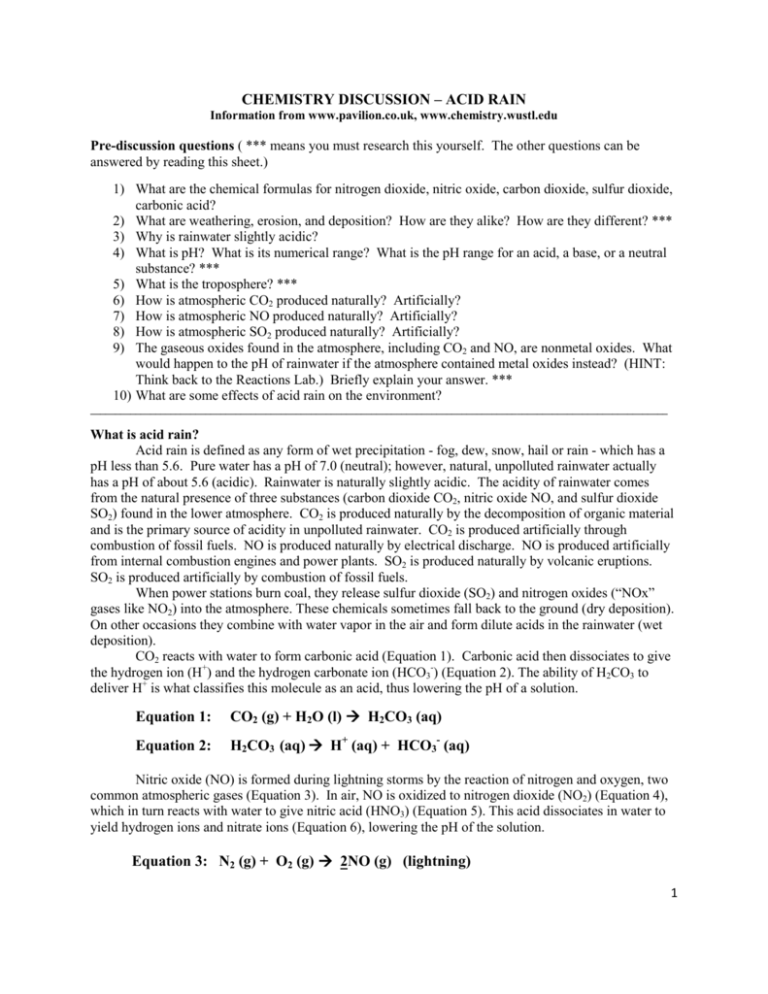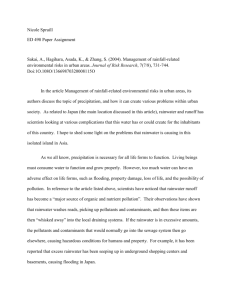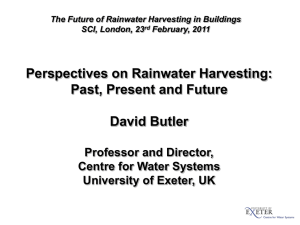CHEMISTRY DISCUSSION – ACID RAIN Equation 1: CO 2 (g) +
advertisement

CHEMISTRY DISCUSSION – ACID RAIN Information from www.pavilion.co.uk, www.chemistry.wustl.edu Pre-discussion questions ( *** means you must research this yourself. The other questions can be answered by reading this sheet.) 1) What are the chemical formulas for nitrogen dioxide, nitric oxide, carbon dioxide, sulfur dioxide, carbonic acid? 2) What are weathering, erosion, and deposition? How are they alike? How are they different? *** 3) Why is rainwater slightly acidic? 4) What is pH? What is its numerical range? What is the pH range for an acid, a base, or a neutral substance? *** 5) What is the troposphere? *** 6) How is atmospheric CO2 produced naturally? Artificially? 7) How is atmospheric NO produced naturally? Artificially? 8) How is atmospheric SO2 produced naturally? Artificially? 9) The gaseous oxides found in the atmosphere, including CO2 and NO, are nonmetal oxides. What would happen to the pH of rainwater if the atmosphere contained metal oxides instead? (HINT: Think back to the Reactions Lab.) Briefly explain your answer. *** 10) What are some effects of acid rain on the environment? ___________________________________________________________________________________________________________________ What is acid rain? Acid rain is defined as any form of wet precipitation - fog, dew, snow, hail or rain - which has a pH less than 5.6. Pure water has a pH of 7.0 (neutral); however, natural, unpolluted rainwater actually has a pH of about 5.6 (acidic). Rainwater is naturally slightly acidic. The acidity of rainwater comes from the natural presence of three substances (carbon dioxide CO2, nitric oxide NO, and sulfur dioxide SO2) found in the lower atmosphere. CO2 is produced naturally by the decomposition of organic material and is the primary source of acidity in unpolluted rainwater. CO2 is produced artificially through combustion of fossil fuels. NO is produced naturally by electrical discharge. NO is produced artificially from internal combustion engines and power plants. SO2 is produced naturally by volcanic eruptions. SO2 is produced artificially by combustion of fossil fuels. When power stations burn coal, they release sulfur dioxide (SO2) and nitrogen oxides (“NOx” gases like NO2) into the atmosphere. These chemicals sometimes fall back to the ground (dry deposition). On other occasions they combine with water vapor in the air and form dilute acids in the rainwater (wet deposition). CO2 reacts with water to form carbonic acid (Equation 1). Carbonic acid then dissociates to give the hydrogen ion (H+) and the hydrogen carbonate ion (HCO3-) (Equation 2). The ability of H2CO3 to deliver H+ is what classifies this molecule as an acid, thus lowering the pH of a solution. Equation 1: CO2 (g) + H2O (l) H2CO3 (aq) Equation 2: H2CO3 (aq) H+ (aq) + HCO3- (aq) Nitric oxide (NO) is formed during lightning storms by the reaction of nitrogen and oxygen, two common atmospheric gases (Equation 3). In air, NO is oxidized to nitrogen dioxide (NO2) (Equation 4), which in turn reacts with water to give nitric acid (HNO3) (Equation 5). This acid dissociates in water to yield hydrogen ions and nitrate ions (Equation 6), lowering the pH of the solution. Equation 3: N2 (g) + O2 (g) 2NO (g) (lightning) 1 Equation 4: 2NO (g) + O2 (g) 2NO2 (g) Equation 5: 3NO2 (g) + H2O (l) 2HNO3 (aq) + NO (g) Equation 6: HNO3 (aq) H+ (aq) + NO3- (aq) About one-fourth of the acidity of rain is accounted for by nitric acid (HNO3). What about the other 75% of the acidity of rain? Most is accounted for by the presence of sulfuric acid (H2SO4) in rainwater. Although sulfuric acid may be produced naturally in small quantities from biological decay and volcanic activity, it is produced almost entirely by human activity, especially the combustion of sulfur-containing fossil fuels in power plants. When these fossil fuels are burned, the sulfur contained in them reacts with oxygen from the air to form sulfur dioxide (SO2). Combustion of fossil fuels accounts for approximately 80% of the total atmospheric SO2 in the United States. Sulfur dioxide, like the oxides of carbon and nitrogen, reacts with water to form sulfuric acid (Equation 7-8). Equation 7: SO2 (g) + O2 (g) SO3 (g) Equation 8: SO3 (g) + H2O (l) H2SO4 (aq) Sulfuric acid is a strong acid, so it readily dissociates in water, to give an H+ ion and an HSO4- ion (Equation 9). The HSO4- ion may further dissociate to give H+ and SO42- (Equation 10). Thus, the presence of H2SO4 causes the concentration of H+ ions to increase dramatically, and so the pH of the rainwater drops to harmful levels. Equation 9: H2SO4 (aq) H+ (aq) + HSO4- (aq) Equation 10: HSO4- (aq) H+ (aq) + SO42- (aq) Acidity of polluted rainwater Unfortunately, human industrial activity produces additional acid-forming compounds in far greater quantities than the natural sources of acidity. In some areas of the United States, the pH of rainwater can be 3.0 or lower, approximately 1000 times more acidic than normal rainwater. When rainwater is too acidic, it can cause problems such as killing freshwater fish, damaging crops, and eroding buildings and monuments. Humans cause many combustion processes that dramatically increase the concentrations of acidproducing oxides in the atmosphere. Although CO2 is present in a much higher concentration than NO and SO2, CO2 does not form acid to the same extent as the other two gases. Thus, a large increase in the concentration of NO and SO2 significantly affects the pH of rainwater, even though both gases are present at much lower concentration than CO2. In addition to the natural processes that form small amounts of nitric acid (HNO3) in rainwater, hightemperature air combustion, such as occurs in car engines and power plants, produces large amounts of NO gas. This gas forms nitric acid through Equations 4 and 5. Thus, a process that occurs naturally at levels tolerable by the environment can harm the environment when human activity causes the process (formation of nitric acid) to occur to a much greater extent. 2







